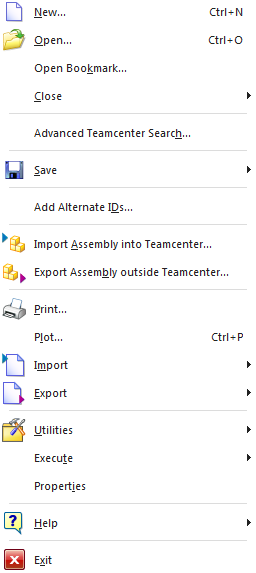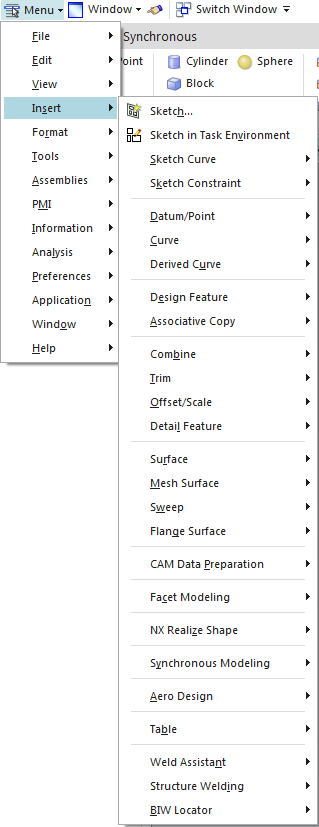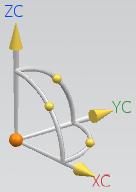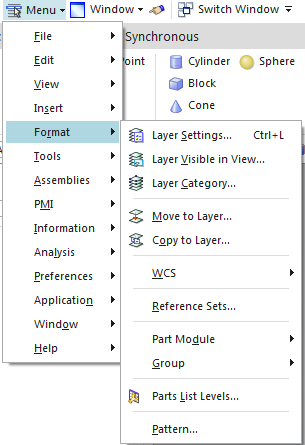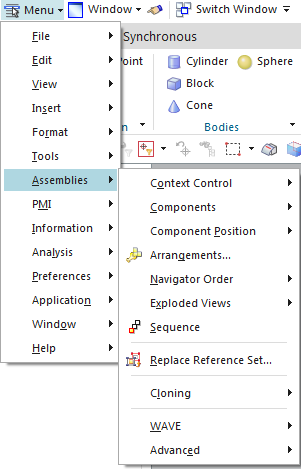Since a complete description of all the elements in the menu bar would be too extensive, the following text only describes the basic elements. Additional elements will be explained in following chapters if necessary.
| Hint: |
|
Menu File
Create a new model and save it with the name NX according to the naming convention. (refer chapter 2.7 "Creating a new item")
You can select different operating modes in the menu File.
The function Modeling, which you are using now, starts NX's modeling mode. In this mode you can design models and assemblies.
The function Drafting switches to the drafting mode. In this mode you can create technical drafts of a CAD-Model/Assembly. (figure "Start")
The selected operating mode is displayed on the right side in the file menu. If you click the button again when you are already in this mode, a window pops up, in which you can edit other preferences (e.g. display) for the selected mode.
Furthermore, the file menu contains general data mangement options, like save, open or exporting to other data types. If you are using NX connected to a PDM-System like Teamcenter, the PDM-System's rules for saving, etc. apply. You can access this menu in every operating mode. (figure "File")
Menu Edit
The menu Menu -> Edit contains functions for editing your CAD-Model.
General functions are Undo, Redo, Cut, Copy, Paste, and Delete. You can use these like in standard text editing software.
Selection gives you different filters for selecting specific elements of your model.
The function Show and Hide (Strg+W) allows you to hide or show different types of elements. Objects you want to hide can be selected directly in your displayed model or by right-clicking in the assembly navigator or by using Edit-->Show and Hide-->Show and Hide / Strg+W.
The function Object Display allows you to assign colors to different elements of your CAD-Model. You can also adjust their translucency. You can select elements you want to edit like you would when hiding elements (see above). (figure "Edit")
| Attention: |
|
Menu View
View contains almost every option to edit the view of your CAD-model. Besides functions for navigation (Operation -> Rotate, Operation -> Pan , Operation -> Fit and Operation -> Zoom) you can select various view options. Refer chapter 3.7.1. "View options".
By clicking Operation -> Refresh (Shortcut F5), you can re-render your view (view of your CAD-model). (figure "View")
Menu Insert
The menu Insert is only available in modeling mode (File -> Modeling). This menu contains every function to generate the geometry of CAD-models.
The menu Elements Sketch, Curve, Curve from Curves and Curve from Bodies are used to generate points, lines, curves and vertices; the other menu elements are used for feature based modeling. (figure "Insert")
Menu Format
The menu Format contains various formatting options for your CAD-model. The most important elements of this menu are used for working with layers. You can assign different elements to layers and if necessary you can stack layers to generate specific views.
Additionally, this menu contains the element WCS, used for working with the "Work Coordinate System". You can activate and disable it by using this option.
The WCS is a special feature of NX. It is an individually and universally positionable coordinate system, which you can use for construction and it can be (partially) mandatory. Coordinates and directions you have to enter during construction always refer to the coordinates of the displayed WCS. In some circumstances it's advisable to move the WCS to a practical position before starting to construct a geometric element.
The function Dynamics switches between simple and dynamic WCS. You can freely rotate and translate the dynamic WCS by clicking the handles (big ball in die origin, arrows of the coordinate axes, or small balls between the axes) with your mouse. (figure "Dynamic WCS")
The function Rotate allows you to turn the WCS in a defined angle around an axis (X,Y, or Z).
The function Orient allows you to position the WCS. The WCS can be positiond on model elements, like corners or other points. It can also be moved along the coordinate axes by using the input area. (figure "Format")
Menu Tools
The menu Tools contains tools for editing your CAD-model.
The function Expressions contains a summary of every defined parameter of your CAD-model. Every parameter can be edited freely by using this menu (changing values, names, defining parametric functions, etc.). You can find additional information about parametrics in chapter 4.6. "parametrics" (figure "Tools")
Menu Assemblies
The menu Assemblies contains every function needed to assemble assemblies. (figure "Assemblies")
Menu Information
The menu Information contains general information about your model. (figure "Information")
Menu Analysis
The menu Analysis contains functions for analysing a model.
Measure Distance measures distances between two model elements.
The function Measure Angle measures the angle between two model elements. (figure "Analysis")
Menu Preferences
The menu Preferences (Strg+2) contains various preferences for configurating your CAD-system.
The function Visualization allows you to edit color preferences of NX. (figure "Preferences")
Menu Window
In Window you can switch between different windows (models/assemblies) you want to display. (figure "Window")
Menu Help
The menu Help offers help for various functions of NX.
The function On Context explains individual menu elements or icons.
The function Command Finder allows you to search for different functions, like Edge Blend. (see chapter 3. 4. Command Finder). You can access the command finder on the upper right in the green bar at any time. (figure "Help")
You can also find some of the menus explained above as ribbon tabs. Here you can click the equivalent buttons of some commonly used functions.

